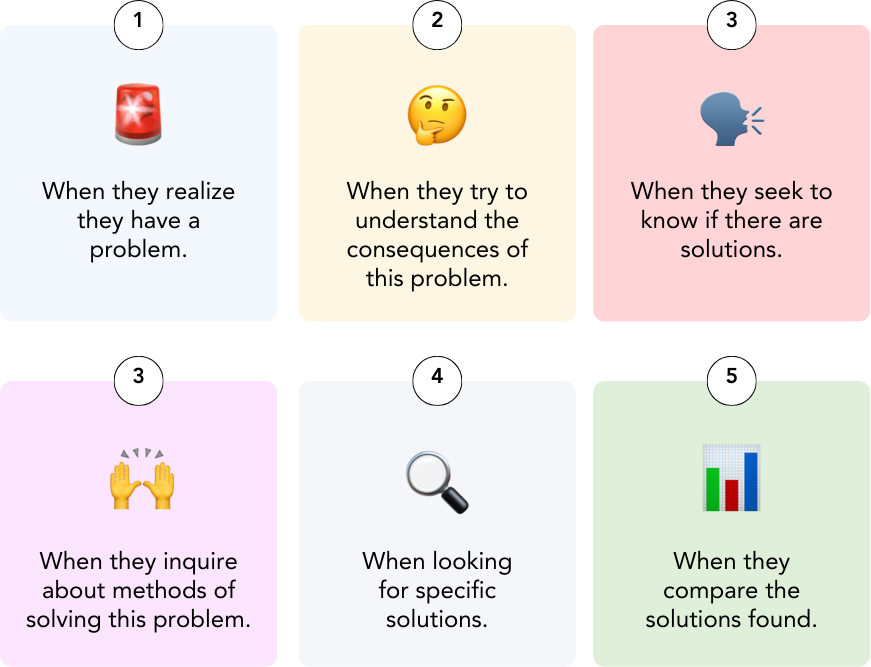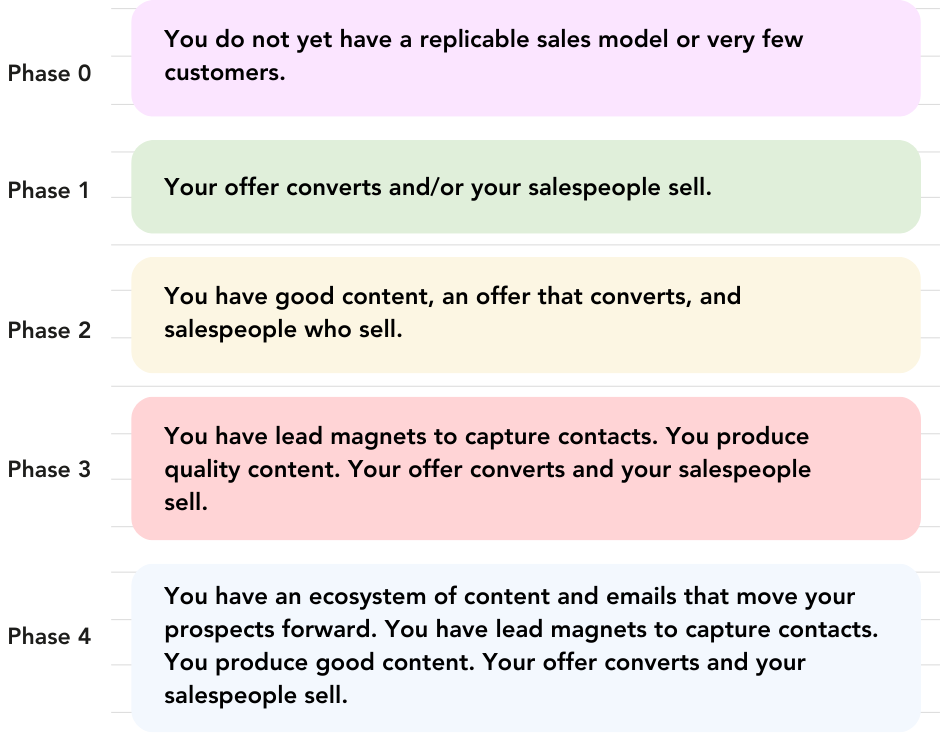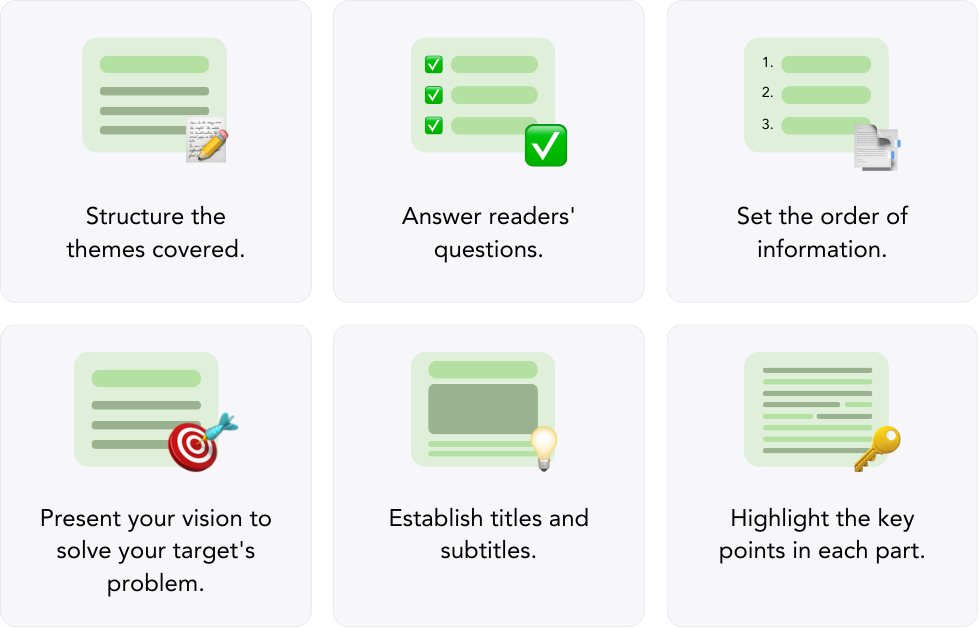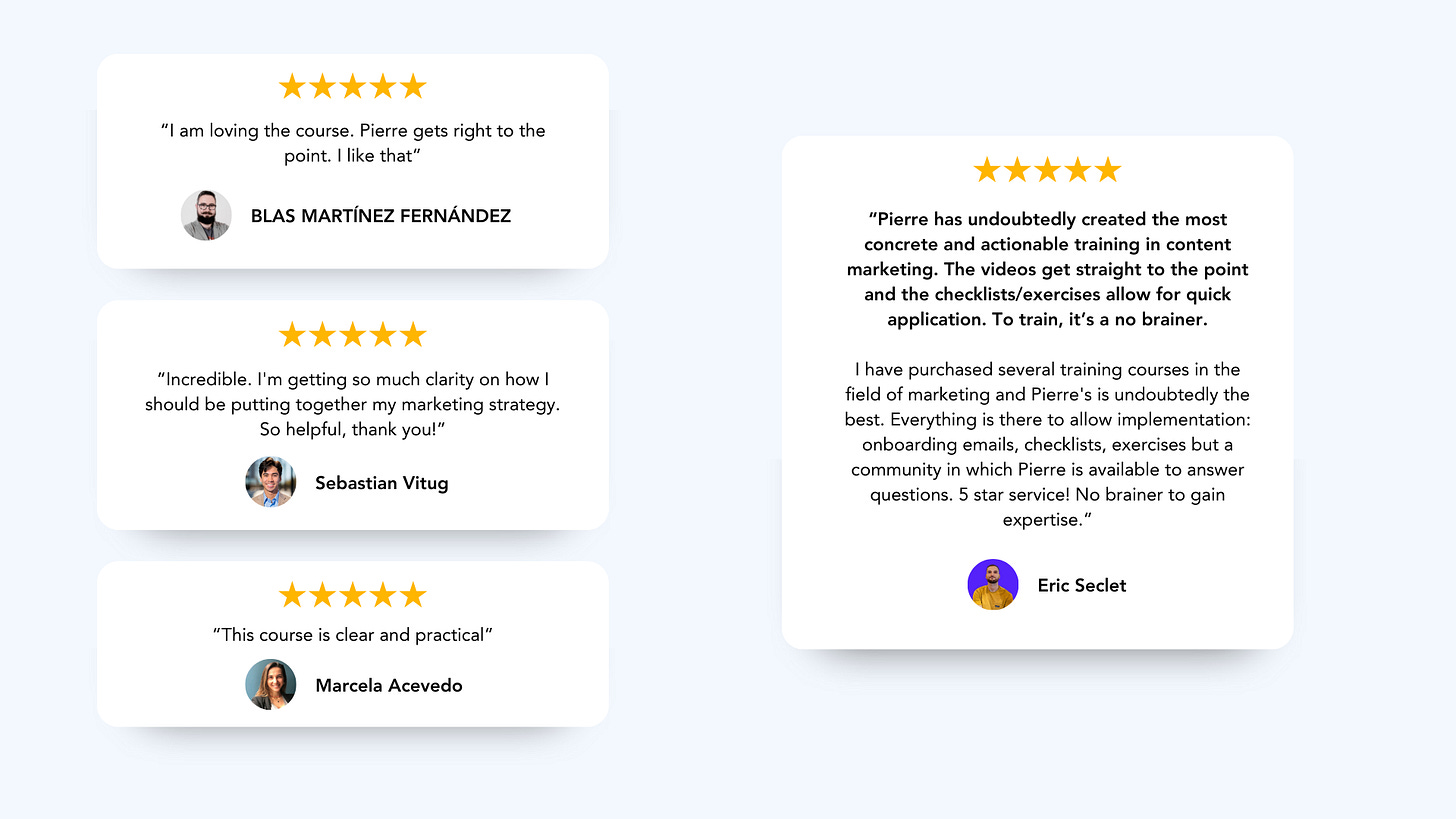Full SEO Guide for B2B in 2024
Learn how to launch and scale your SEO in this illustrated guide
👋 Hey welcome to this edition about SEO in B2B
In this edition, you will learn how to:
Determine if SEO is a viable opportunity for your business.
Identify the keywords your audience is searching for.
Clean and group your keywords.
Develop your content strategy.
Create content that captures the attention of potential customers.
I partnered with one of my course students, Pierre-André Patry who is a SEO expert. He has generated over $10,000,000 in revenue for the 120+ clients including brands like Aircall, Honda, Alan, and various startup studios.
→ Contact him if you have any question about SEO
Here’s a quote from him:
“I strongly believe that SEO is the sweet spot for B2B brands looking to build a sustainable and profitable marketing system in the long run. Now, I share my learnings through my LinkedIn posts and Substack newsletter to help B2B brands achieve their marketing goals.”
Before jumping into the SEO Guide:
🎉 I’m launching a new Coaching Program to help you build authority and get inbound leads with Content
🎉 Launch Offer: Get more information here
Learn how to build authority and generate inbound demand with content. Get lifetime access to my course and start building your content strategy now.
🎉 Launch Offer: Get more information here
Ok let’s jump into the SEO Guide;
At every stage of your business, you can use Search Engine Optimization (SEO) to:
Educate your audience about the problem you are solving.
Build awareness of your brand.
Position yourself as an industry leader.
Generate organic demand, even when you scale back your efforts.
Move your audience forward in their decision stage.
So SEO is a powerful acquisition channel.
But how can you build and install an effective B2B strategy ?
First, here are some common mistakes:
Creating content without a clear marketing goal.
Producing content without strategic thinking.
Entrust the strategy to an intern.
Ask ChatGPT to do it for you.
If you follow these poor practices, you will likely experience:
Creating content without a clear marketing goal = Very few conversions.
Creating 'top of funnel' content without a purpose = Lots of traffic, no ROI.
Entrust the strategy to an intern = Little or no traffic.
Rely on ChatGPT to handle everything = Posting generic content like everyone else. Hoping that Google and your audience set you apart from the rest.
Why activate SEO?
SEO creates a valuable asset for your business.
You generate more qualified, aware leads thanks to your content.
You become an authority by being in your prospects’ search results.
You stand out from the competition thanks to expert content.
You generate leads organically. Even if you stop your efforts for a month, the SEO machine continues to work.
You attract the most qualified traffic on the market. They are actively seeking solutions to their problems.
In the long run, acquisition costs are lower than with paid channels.
Step 1: Know your target
To generate revenue with SEO, you need to be in the search results of potential buyers.
This is the starting point of an SEO strategy.
Is your audience searching for solutions to their problem on Google?
“Everyone uses Google when they have a problem. ”
Unfortunately no.
Some markets have few players. Customers already know the suppliers. So everything must start from your knowledge of the market.
Before you think about SEO, make sure you can clearly answer these questions:
What am I selling?
What transformation do I bring to my clients?
Who is my target customer?
What problem do I solve for my customers?
What result do my clients want?
Do I have replicable sales logic in place?
Without clear answers to these questions, SEO will not work.
Once you meet these prerequisites, you can start SEO.
Put your knowledge of the market to the benefit of the strategy. After understanding the market, formalize your strategy. This will maximize your work during the strategy phase.
Here is the information to gather:
What problem am I solving?
What is the name of my product category?
What transformations do I promise?
Who am I selling my product to?
What are the alternatives to my solution? (excluding competitors)
Who are my competitors in my market?
What features does my product have?
What questions do my customers ask when purchasing?
What symptoms occur before resolving the problem?
What do my customers call my product category?
The goal is to make yourself present at each phase of the problem resolution journey:
When they realize they have a problem.
When they try to understand the consequences of this problem.
When they seek to know if there are solutions.
When they inquire about methods of solving this problem.
When looking for specific solutions.
When they compare the solutions found.
This will allow you to target the right people with the right message.
Step 2: Find searches typed by your audience
To attract the right people, be visible during their searches.
Keywords materialize these searches.
Without keywords, no traffic.
To find these keywords, use three methods:
Google Ads : Go to the Google Ads keyword planner tool. Then use the keyword patterns you gathered in step 1. This method inreases exploitable opportunities for the rest of the strategy.
Competitor Analysis : To find your competitors’ keywords, use a tool like SEMrush. Enter the name of one of your competitors and identify the keywords on which they position themselves. You'll get its position, search volume, traffic, and the ranked page
Google Search Console : Use it to find specific, low-competition keywords. They do not appear in other SEO tools. These keywords deliver results swiftly, yielding high conversion rates
.
In the “Performance” tab of your Google Search Console, export the keywords you appear on. Add them to your keyword list.
Step 3: Clean the data and organize it
Once you have done your keyword research, you will get a list of many keywords.
To target your efforts on the right opportunities, you must:
Clean up your keyword list.
Group similar keywords into clusters.
Clean up the keyword list
To be effective, start by cleaning this list.
Remove keywords that:
Are off topic.
Do not match your target.
Are duplicates.
Group similar keywords
Once you clean your keyword list, group them by search intent.
Search intent is what the user wants when searching for a keyword.
Example :
Isolation bureau
Office insulation
Insulate your office
All these keywords express the same search intent.
Once you form your keyword groups, you will have the list of content to create for your SEO strategy.
Each group of keywords corresponds to content.
A good way to group keywords is to compare similar results in Google's top 10. If the results are 40% similar, you can group them together.
If you do not group your keywords, you risk creating content:
Which will be duplicated on your site.
Which will disrupt the navigation of Internet users.
This leads to unnecessary budget expenditures.
Google won't know what content to highlight, which will hurt your performance.
By creating relevant content, Google will show you on all the keywords in the group.
Step 4: Create your content strategy
After establishing your list of content to produce, create your content strategy.
To do this, proceed as follows:
Qualify your content opportunities.
Focus on these opportunities.
Integrate them into a coherent roadmap.
Qualification of each opportunity
Use these criteria to qualify your opportunities:
Page type.
Conversion potential.
Group keywords.
Search volume on group keywords.
Competition score.
Position in the purchasing journey.
Status - Existing content creation or optimization.
Current position - If you are already visible.
Page that is currently positioned on this keyword - If you are already visible.
Content marketing goal - sales, request generation, email retrieval…
Once you complete your strategy file, you will have a clear vision of:
The type of content to produce.
The size of the traffic opportunity.
The quality of the traffic you bring.
The intention to buy or get information.
The aim of the content.
This information allows you to focus on your actions.
Check your marketing maturity
Before prioritizing your content, determine your marketing phase. Here is how I categorize marketing maturity:
Phase 0 : You do not yet have a replicable sales model or very few customers.
Phase 1 : Your offer converts and/or your salespeople sell.
Phase 2 : You have good content, an offer that converts, and salespeople who sell.
Phase 3 : You have lead magnets to capture contacts. You produce quality content. Your offer converts and your salespeople sell.
Phase 4 : You have an ecosystem of content and emails that move your prospects forward. You have lead magnets to capture contacts. You produce good content. Your offer converts and your salespeople sell.
Depending on your phase:
Phase 0 : Stop here, as explained in the first step, SEO should not be your priority.
Phase 1 and 2 : Focus only on keywords very close to the buy.
Phase 3: Start with buying keywords, then expand to less related content.
Phase 4 : Focus on keywords close to the buy, then move up the funnel to the top.
Why not address all content opportunities?
→ The goal is not to generate traffic, but to generate income.
Without a system to advance your leads, you'll waste your budget. You'll attract traffic that isn't ready to buy. Focus your efforts on traffic that you are capable of converting.
Prioritization of opportunities
In some markets, you will have plenty of content opportunities to create.
For a better return on investment, focus on opportunities. Avoid spreading yourself too thin.
The above criteria allow you to define a priority score for each opportunity.
You can use Pierre-André’s star system:
3 stars: High priority.
2 stars: Medium priority.
1 star: Low priority.
High priority corresponds to content having:
High conversion potential.
An interesting volume of research.
An audience ready to buy and looking for a solution.
Medium priority corresponds to:
Strong or medium conversion potential.
Lower search volume.
An audience in the information phase.
Low priority corresponds to:
Low conversion potential.
Low search volume.
An audience far removed from the purchasing decision.
Creation of the content roadmap
Creating the roadmap is the quickest step.
Once well qualified and prioritized, the opportunities build the roadmap.
Here's how to do it:
Check how much content you can create each week or month.
Organize a calendar. Start with the most important content. Finish with the lowest priority ones.
Step 5: Create content visible to your future customers
Before generating income thanks to SEO, your content must be read by your target.
So you need to please both Google and your audience.
We will link, step by step, these two elements to the success of an SEO strategy.
After this fifth step, you will know:
Understand the importance of an editorial brief.
Create a relevant editorial brief.
Write relevant and visible content for your audience.
Write content that will satisfy your visitors.
Creation of the editorial brief
The editorial brief forms the basis of good content. It allows:
To make your content visible to the right people.
To satisfy readers.
To create a good editorial brief, understand what the reader wants by typing in a keyword.
Your knowledge of the target and of Google helps us find the most satisfactory content.
Google can check:
Time spent on a page.
Bounce rate (the unsatisfaction rate, in reality)
The number of interactions with content (scroll, forms, pages visited, etc.).
Google favors content that thoroughly meets user needs.
We will analyze the structure of the best content by searching for our keywords.
Here are the criteria to examine as a priority:
Page type: blog post or site page.
Type of content: explanatory article, tutorial, comparison, tool, etc.
Content size: short, medium, long article?
Number of words.
Media name.
Media types (images, infographics, videos).
Recurring themes in the best articles.
Presence of external links.
Citation of sources.
Angles adopted by high-performance content.
Important lexical field present in the content.
These criteria allow you to create an article template. Use it as a basis for writing or delegate it to an editor.
Define the content plan
After analyzing competing content and choosing your angle, define your content plan.
The content plan helps you:
Structure the themes covered.
Answer readers' questions.
Set the order of information.
Present your vision to solve your target's problem.
Establish titles and subtitles.
Highlight the key points in each part.
This plan simplifies writing by giving you a clear roadmap.
Content creation
After planning your content plan, write it.
Use your draft and brief to write an article that visitors will enjoy.
No strict rules on keyword integration or number of links. Produce high-quality content that surpasses your competitors' efforts.
Add relevant sections and adopt an angle that reflects your vision.
If your content plan and brief are well designed, writing will not be a problem.
Craft your content with precision. Or, delegate it to a pro if you're not comfortable.
Make your content engaging and revenue-generating
Congratulations, you have created content:
Relevant to your audience.
Aligned with Google quality standards.
Unfortunately, this is not enough to generate income.
You must now:
Create engagement.
Check that your content achieves its marketing goal.
To do this, proceed in the following order:
Make your content enjoyable to read.
Make sure it is consistent with your marketing goal.
Add a next step for your reader.
To make your content pleasant to read, ensure its readability and clarity:
Avoid jargon.
Use short sentences.
Insert break lines.
Be specific in what you say.
Keep only essential information.
Delete superfluous sentences.
The Hemingway Score can help you assess the readability of your content.
The role of content and your product
When your target types a keyword, they are trying to get from point A to point B.
Point A corresponds to its current situation. Point B represents his ideal situation.
Your content and product should bridge the gap between reality and your reader's dream.
Without this goal in mind, your content will not generate leads or revenue.
The role of the Call To Action
The Call To Action (CTA) invites the reader to act.
Remember that your reader is trying to get to point B.
The role of the CTA is to tell him how to take the bridge to reach his dream situation.
It can take different forms:
Quote form.
Contact form.
Simulation to project the reader into their dream situation.
Retrieving contact information.
Visual.
Link to a sales page.
Lack of a call to action yields low conversion rates.
You play an advisory and support role. The reader finds himself in a situation that he cannot control and seeks guidance.
You must thus lead him towards his dream situation.
But, your CTA should match the prospect's decision phase.
A common mistake is offering a CTA to a sales page or demo. The reader is not yet ready to buy.
The number of conversions in this case will be very low.
What is the best option in this case?
Offer to download more detailed content to help them solve their problem.
Collect their email. Send them relevant content at every stage of their problem resolution.
You can't force your reader to buy.
You can guide him through these steps:
Not aware of the problem.
Aware of the problem.
Wondering if there are solutions.
Looking for a solution.
Compare the solutions.
Your role is to guide your reader from one step to the next, until the sale.
By helping him solve his problem, you have a good chance that he will complete his journey with you.
To conclude this playbook, remember these 6 key principles:
Your strategy must start with thorough market research.
Keywords are the main indicator of your audience's interests. No keywords, no traffic.
Group your keywords to avoid budget waste and future technical issues.
Ensure you’re delivering the content that both your audience and Google are looking for.
When reviewing your content, ask yourself: "Will my clients experience a ‘Wow’ effect when they read this?"
Is your Call to Action aligned with the decision stage of your reader? Ensuring this will help achieve a strong conversion rate.
By following this checklist, there’s no reason your B2B SEO strategy won’t be successful in the long run.
Alright that’s the end of this edition! Big thanks to Pierre-André Patry who is a SEO expert. Contact him if you have any question.
🎉 I’m launching a new Coaching Program to help you build authority and get inbound leads with Content
🎉 Launch Offer: Get more information here
Learn how to build authority and generate inbound demand with content. Get lifetime access to my course and start building your content strategy now.
🎉 Launch Offer: Get more information here

































A SEO masterclass in one post, bravo 👏